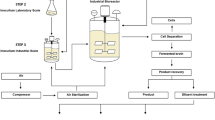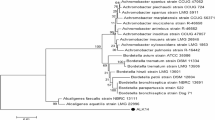Abstract
This article presents a study of the efficiency and degradation pattern of samples of petroleum sludge and polluted sandy soil from an oil refinery. A bacterial consortium, consisting of strains from the genera Pseudomonas, Achromobacter, Bacillus and Micromonospora, was isolated from a petroleum sludge sample and characterized. The addition of nitrogen and phosphorus nutrients and a chemical surfactant to both the samples and bioaugmentation to the soil sample were applied under laboratory conditions. The extent of biodegradation was monitored by the gravimetric method and analysis of the residual oil by gas chromatography. Over a 12-week experiment, the achieved degree of TPH (total petroleum hydrocarbon) degradation amounted to 82–88% in the petroleum sludge and 86–91% in the polluted soil. Gas chromatography–mass spectrometry was utilized to determine the biodegradability and degradation rates of n-alkanes, isoprenoids, steranes, diasteranes and terpanes. Complete degradation of the n-alkanes and isoprenoids fractions occurred in both the samples. In addition, the intensities of the peaks corresponding to tricyclic terpenes and homohopanes were decreased, while significant changes were also observed in the distribution of diasteranes and steranes.





Similar content being viewed by others
References
Alvarez PJJ, Illman WA (2006) Bioremediation and natural attenuation: process fundamentals and mathematical models. Wiley, Hoboken
Arafa MA (2003) Biodegradation of some aromatic hydrocarbons (BTEXs) by a bacterial consortium isolated from polluted site in Saudi Arabia. Pak J Biol Sci 6:1482–1486
Arvanitis N, Katsifas E, Chalkou KI, Meintanis C, Karagouni AD (2008) A refinery sludge deposition site: presence of nahH and alkJ genes and crude oil biodegradation ability of bacterial isolates. Biotechnol Lett 30:2105–2110
Bautista LF, Sanz R, Molina MC, Gonzales N, Sanchez D (2009) Effect of different non-ionic surfactants on the biodegradation of PAHs by diverse aerobic bacteria. Int Biodeterior Biodegrad 63:913–922
Cameotra SS, Singh P (2008) Bioremediation of oil sludge using crude biosurfactants. Int Biodeterior Biodegrad 62:274–280
Das N, Chandran P (2011) Microbial degradation of petroleum hydrocarbon contaminants: an overview. Biotechnol Res Int. doi:10.4061/2011/941810
DIN-EN 14345 (2004) Characterization of waste—determination of hydrocarbon content by gravimetry
EPA SW-846 method 3051 (1995) Microwave assisted acid digestion of sediments, sludges, soil and oils. In: Test methods for evaluating solid waste, 3rd edn, 3rd Update, US Environmental Protection Agency, Washington
Fuentes MS, Benimeli CS, Cuozzo SA, Amoroso MJ (2010) Isolation of pesticide-degrading actinomycetes from a contaminated site: bacterial growth, removal and dechlorination of organochlorine pesticides. Int Biodeterior Biodegrad 64:434–441
Gentry JT, Rensing C, Pepper IL (2004) New approaches for bioaugmentation as a remediation technology. Crit Rev Environ Sci Technol 34:447–494
Ghazali FM, Rahman RNZA, Salleh AB, Basri M (2004) Biodegradation of hydrocarbons in soil by microbial consortium. Int Biodeterior Biodegrad 54:61–67
Haack SK, Garchow H, Odelson DA, Forney LJ J, Klug MJ (1994) Accuracy, reproducibility, and interpretation of fatty acid methyl ester profiles of model bacterial communities. Appl Environ Microbiol 60:2483–2493
Hopwood DA, Bibb MJ, Chater KF, Kieser T, Bruton CJ, Kieser HM, Lydiate DJ, Smith CP, Wards JM, Shrempf H (1985) Genetic manipulation of Streptomyces: a laboratory manual, 1st edn. John Innes Foundation, Norwich
Ijah UJJ, Antai SP (2003) Removal of Nigerian light crude oil in soil over a 12-month period. Int Biodeterior Biodegrad 51:93–99
Ito H, Hosokawa R, Morikawa M, Okuyama H (2008) A turbine oil-degrading bacterial consortium from soils of oil fields and its characteristics. Int Biodeterior Biodegrad 61:223–232
Kausar H, Sariah M, Mohd Saud H, Zahangir Alam M, Razi Ismail M (2011) Isolation and screening of potential actinobacteria for rapid composting of rice straw. Biodegradation 22:367–375
Koma D, Sakashita Y, Kubota K, Fujii Y, Hasumi F, Chung SY, Kubo M (2003) Degradation of car engine oil by Rhodococcus sp. NDKK48 and Gordonia sp. NDKY76A. Biosci Biotechnol Biochem 67:1590–1593
Lane DJ (1991) 16S/23S rRNA sequencing. In: Stackebrandt E, Goodfellow MM (eds) Nucleic acid techniques in bacterial systematic. Wiley, Chichester, pp 115–175
Liu JS, Xie XH, Xiao SM, Wang XM, Zhao WJ, Tian ZL (2007) Isolation of Leptospirillum ferriphilum by single-layered solid medium. J Cent South Univ Technol 4:467–473
Löser C, Seidel H, Zehnsdorf A, Stottmeister U (1998) Microbial degradation of hydrocarbons in soil during aerobic/anaerobic changes and under purely aerobic conditions. Appl Microbiol Biotechnol 49:631–636
Mishra S, Jyot J, Kuhad RC, Lal B (2001) Evaluation of inoculum addition to stimulate in situ bioremediation of oily-sludge-contaminated soil. Appl Environ Microbiol 67:1675–1681
Mulligan CN, Yong RN, Gibbs BF (2001) Surfactant-enhanced remediation of contaminated soil: a review. Eng Geol 60:371–380
Namio K, Haruki M, Takano S, Morikawa M, Kanaya S (2005) Isolation and characterization of Rhodococcus sp. strains TMP2 and T12 that degrade 2,6,10,14-tetramethylpentane (pristane) at moderately low temperatures. J Biotechnol 115:129–136
Nieto JJ, Fernandez-Castillo R, Marquez MC, Ventosa A, Quesada E, Ruiz-Berraquero F (1989) Survey of metal tolerance in moderately halophilic eubacteria. Appl Environ Microbiol 55:2385–2390
Perry JJ (1984) Microbial metabolism of cyclic alkanes. In: Atlas RM (ed) Petroleum microbiology. MacMillan Publishing Company, New York, pp 61–98
Peters KE, Walters CC, Moldovan JM (2005) The biomarker guide. Cambridge University Press, Cambridge
Rahman KSM, Rahman TJ, Kourkoutas Y, Petsas I, Marchant R, Banat IM (2003) Enhanced bioremediation of n-alkane in petroleum sludge using bacterial consortium amended with rhamnolipid and micronutrients. Bioresour Technol 90:159–168
Rump HH (1999) Laboratory manual for the examination of water, waste water and soil. 3rd edn, Wiley-VCH Verlag GmbH, Weinheim, pp 144–190
Thompson IP, van der Gast CJ, Ciric L, Singer AC (2005) Bioaugmentation for bioremediation: the challenge of strain selection. Environ Microbiol 7:909–915
Vasudevan N, Rajaram P (2001) Bioremediation of oil sludge-contaminated soil. Environ Int 26:409–411
Verma S, Bhargava R, Pruthi V (2006) Oily sludge degradation by bacteria from Ankleshwar, India. Int Biodeterior Biodegrad 57:207–213
Walker JD, Colwell RR, Petrakis L (1975) Microbial petroleum degradation: application of computerized mass spectrometry. Can J Microbiol 21:1760–1767
Wang Z, Fingas MF (2003) Development of oil hydrocarbon fingerprinting and identification techniques. Mar Pollut Bull 47:423–452
Ward O, Singh A, Van Hamme J (2003) Accelerated biodegradation of petroleum hydrocarbon waste. J Ind Microbiol Biotechnol 30:260–270
Wentzel A, Ellingsen TE, Kotlar HK, Zotchev SB, Throne-Holst M (2007) Bacterial metabolism of long chain n-alkanes. Appl Microbiol Biotechnol 76:1209–1221
Wongsa P, Tanaka M, Ueno A, Hasanuzzaman M, Yumoto I, Okuyama H (2004) Isolation and characterization of novel strains of Pseudomonas aeruginosa and Serratia marcescens possessing high efficiency to degrade gasoline, kerosene, diesel oil, and lubricating oil. Curr Microbiol 49:415–422
Zvyagintseva IS, Suroviseva EG, Polglazova MN, Ivoilov VS, Belyaev SS (2001) Degradation of machine oil by nocardioform bacteria. Microbiology 70:270–276
Acknowledgments
This study was supported by the Ministry of Science and Technological Development of the Republic of Serbia (III 43004).
Author information
Authors and Affiliations
Corresponding author
Electronic supplementary material
Below is the link to the electronic supplementary material.
Rights and permissions
About this article
Cite this article
Gojgic-Cvijovic, G.D., Milic, J.S., Solevic, T.M. et al. Biodegradation of petroleum sludge and petroleum polluted soil by a bacterial consortium: a laboratory study. Biodegradation 23, 1–14 (2012). https://doi.org/10.1007/s10532-011-9481-1
Received:
Accepted:
Published:
Issue Date:
DOI: https://doi.org/10.1007/s10532-011-9481-1




